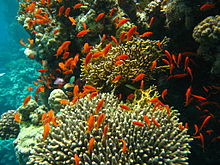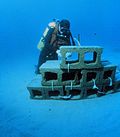Artificial coral reef
Artificial reefs are made or man are technically restored coral reefs . The techniques used enable both the creation and the restoration of damaged coral reefs, which can serve as an attraction for divers and snorkelers.
Even in the early stages of these projects, the results in the growth of corals and fish populations were astonishing .
Use
When natural coral reefs die, so do fish stocks. The beaches and coasts are exposed to the force of the surf and are eroding. No longer protected by their natural breakwaters, some stretches of coast are losing huge areas and many people are losing their livelihood. (see also coastal protection )
Studies show that the quantity of populations in artificial reefs is roughly comparable to that of natural reefs. Compared to natural formations, the biodiversity is less in the first years of construction and adjusts itself with increasing age.
For ecotourism and the hotels in the Maldives , Indonesia and Panama, artificial reefs are a great attraction . Hotels already advertise their existence and the fact that tourists can dive right on their doorstep and observe the diversity of the sea.
During the 1998 coral bleaching, less than 5% of the corals in the Maldives survived. On the other hand, more than 80% of the corals survived on the artificial reefs of the Global Coral Reef Alliance . Shortly after the ocean warmed, they recovered completely and colonized the surrounding natural habitats again.
distribution
There are now newly built reefs on the Maldives , Pemuteran and Tulamben on Bali , the Seychelles , Thailand , Indonesia , Israel , India , Papua New Guinea , Mexico and Panama .
In the Atlantic off Miami , the Neptune Memorial Reef is currently being built in around 12 meters of water. Since November 2007, the deceased have been buried there. The Neptune Society wants to create the largest artificial reef in the world there. This underwater cemetery is already attracting fish and amateur divers with its artificial structures and is intended to be the final resting place for 125,000 people.
Also off the coast of Florida, in the Gulf of Mexico , approx. 41 km south of Pensacola , the decommissioned aircraft carrier USS Oriskany was sunk in May 2006 for the purpose of artificial reef formation. It is considered the largest artificial reef in the world and is called the Great Carrier Reef , based on the Australian Great Barrier Reef . The wreck of the Cayman Salvage Master also serves as a reef.
history
The artificial reef is not a new invention. The first documented tradition comes from Madagascar . There, the locals tied coral pieces that happened to be broken off to the rocks with plant fibers, thus ensuring that they grew firmly back on. They were well aware of the value of corals for marine life. Other reports come from Polynesia . There people built fish traps out of stones. At high tide , the fish swam into the trap. If the water ran out with the ebb tide , the fish could not go out again and were caught in the shallow water. Over time, corals settled on the stones of the fish trap and formed a safe shelter for the young fish. The more corals settled on the stones of these traps, the more effective the protection for the fry was.
Compared to structures supported by maintenance and construction measures, only a few corals and other sea creatures settle on sunken ships and concrete structures: the corals on these objects initially lack the limestone substrate on which they can settle.
The Osborne Reef off the east coast of the United States proved a failure for coral resettlement.
In April 2007 the four square meter Tamar Reef was launched off the coast of Eilat . In the same year, various corals were planted on this concrete reef. To do this, divers drilled holes in the concrete and glued the corals grown on a plastic stick into these holes. To date, around 600 corals have been glued to the concrete block. The transplantation of the corals is costly, lengthy and very complex. The number of fish species in this artificial reef is even higher than in a natural reef of the same size.
Example: Biorock process
The Biorock technology was invented by the architect Wolf Hilbertz and the scientist Tom Goreau . The patented process increases the growth rate of corals far beyond the normal value. With the extra energy , a reef community can survive even under conditions that would otherwise mean their death. At the same time, these man-made structures attract a large number of fish and act as breakwaters . While concrete structures such as The Reef Ball Foundation have to do without Kalkan storage, artificial reefs grow with Biorock technology and on. They get stronger and more durable every year.
The artificial reef foundations largely consist of ordinary structural steel or a wire mesh. The material is welded together, is cheap and widely available. The strength of the struts is about one centimeter, while the distances between the struts are 10 to 20 centimeters. The structures are anchored to the seabed. The variety of forms is copied from nature . So far , there are domes , flowers , funnels , pyramids , snails and many other shapes in all sizes. The structures are connected with an insulated copper wire through which direct current is passed. In addition to the normal power grid , car batteries , wind generators , solar collectors or generators can also be used as power sources . While the steel structure is used as the cathode , the anode must be made of a stainless material. The low electrical voltage is completely harmless to swimmers or marine life.
The direct current causes a mineral precipitation from the sea water on the metal. The result is a composite of metal and limestone with a strength similar to concrete. The composition of the material ( calcium carbonate and magnesium hydroxide ) is very similar to that of natural coral reefs.
The electrolytic reaction mainly precipitates dissolved mineral salts from the sea water. Mainly calcium carbonate and magnesium hydroxide are deposited on the steel structure . Colloquially, this deposit is called limestone . This layer envelops the entire steel structure and grows by 1 to 3 cm per year, depending on the electrical energy supplied to the artificial reef. The larger the construction, the more electricity it needs. If enough energy is available, you could even encase a huge shipwreck in limestone and stimulate the corals to grow.
To initiate coral colonization, broken pieces of coral are usually transplanted onto the steel. The more coral pieces are attached to the construction, the faster the marine population of the new reef will grow. For a rapid settlement an intensive continuation of the transplants is necessary at the beginning . The lower parts of the constructions need more coral than the upper parts. The corals and their growth must be monitored regularly.
For an artificial reef, no parts are taken from a healthy reef; However, if reefs have been damaged by careless divers, boat anchors, storms or the like, the pieces are picked up and anchored to the steel structure with a cable tie or wire. On the steel construction, the coral fragments grow firmly together with the subsoil within a few weeks and numerous fish can be found in the vicinity.
Growth, Care and Protection
Coral larvae like to settle on clean limestone because mineral accretion is exactly what they are looking for. The result is a very high population density with natural corals. The artificial reef attracts life, much like an oasis in the desert. After a while, all species can be observed that also occur on natural reefs. There is no known species that cannot cope with life on the artificial form. Instead, there are some organisms on the newly formed limestone skeleton that are challenging the corals for their habitat. These include mussels , barnacles , algae , sponges and a few more species. They will need to be removed from time to time until enough corals have settled.
The longer a project runs, the more corals settle on the construction. If you switch off the electricity after a while, the artificial reef lives on even without the external energy supply . It then just grows much more slowly.
Artificial reefs are built at depths of 5 to 25 meters. This is the depth at which the corals grow best as there is enough light and they do not hinder the boats of tourists and fishermen.
See also
- Carbonate-silicate cycle , technical lime cycle , on the chemistry of sinter formation
- Hard corals
- Redbird Reef
Individual evidence
- ↑ Archived copy ( Memento of the original dated December 20, 2007 in the Internet Archive ) Info: The archive link was inserted automatically and has not yet been checked. Please check the original and archive link according to the instructions and then remove this notice.
- ↑ Neptune Memorial Reef ( Memento of the original from July 22, 2011 in the Internet Archive ) Info: The archive link has been inserted automatically and has not yet been checked. Please check the original and archive link according to the instructions and then remove this notice.
- ↑ [1]
- ↑ In 1990 they founded the Global Coral Reef Alliance, which works to preserve and restore threatened coral reefs.
- ↑ The corals do not find a firm footing in the sand of the sea floor and die after a short time or are simply buried by the sand and the current.
literature
- TF Goreau, NI Goreau, TJ Goreau: Coral and Coral Reefs , in Biology of the Seas, 1991, Spektrum Akad. Verl., ISBN 3-89330-753-2 .
- Electrodeposition of Minerals in Sea Water: Experiments and Applications , in: IEEE Journal on Oceanic Engineering, Vol. OE-4, No. 3, pp. 94-113, 1979.
- Solar-generated construction material from sea water to mitigate global warming , in: Building Research & Information, Volume 19, Issue 4 July 1991, pages 242-255.
- Solar-generated building material from seawater as a sink for carbon , Ambio 1992.
- Yossi Loya and Ramy Klein: Die Welt der Korallen , Jahr Verlag Hamburg, 1998, ISBN 3-86132-226-9 .



